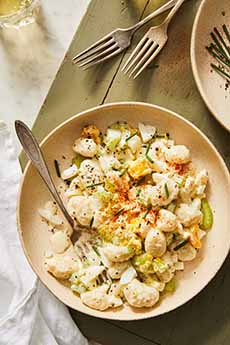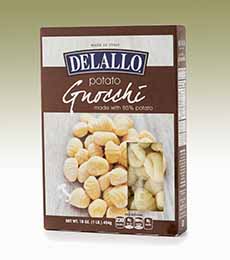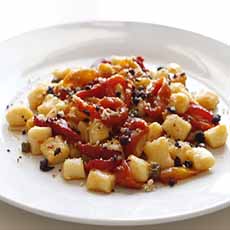Gnocchi Potato Salad Recipe (Or Is It Pasta Salad?)
|
Is it potato salad or is it pasta salad? It’s both: a pasta salad made from potato gnocchi. The next time someone asks you to bring the potato salad to a gathering, surprise them with this recipe. The recipe is below. If you’re not familiar with gnocchi, it’s an Italian dumpling, small and oblong. Gnocchi can be poached (boiled in salted water), baked or fried. The dough ingredients include semolina, ordinary wheat flour, cheese (parmesan, ricotta), potato, and sometimes egg, vegetables (beets, herbs, pesto, pumpkin, spinach), breadcrumbs, cornmeal, chestnut flour, squid ink or other ingredients (see photo # 2). Sometimes they have groove marks, made with a fork or other implement; sometimes they’re smooth with blunt-cut ends. The purpose of the grooves is catch and hold onto the sauce. Gnocchi are also called “pillow pasta,” a group that, according to Wikipedia, includes variations such as: Gnocchi has been made since Roman times. It traveled north with the Roman legions as they expanded their empire across Europe. The name may be derived from the Italian nocchio, meaning a knot in wood; or from nocca, knuckle. Here’s a detailed history of gnocchi. We happened to have a bulb of fennel in the fridge, in addition to the celery required in the recipe. Since we love the light anise flavor of fennel (and it goes with all the other ingredients), we substitute fennel for half of the celery. 1. BRING a large pot of salted water to a boil. Add the gnocchi and cook until they float to the top, about 4 minutes (2 minutes for fresh gnocchi, which will also float to the top). Drain, rinse and set aside to cool. Meanwhile… 2. COMBINE the dressing ingredients from the mustard to the balsamic in a large serving bowl. In a slow, steady stream, whisk in the oil until well combined. 3. ADD the celery and gnocchi to the dressing and toss to coat. Gently stir in the eggs. Garnish with the chives and serve warm or room temperature. The most unusual name for gnocchi is strangolapreti, strangulaprievete pr strangoloprevete. The name means “priest stranglers,” and was bestowed centuries ago when it was common practice in Italy to let priests eat for free in restaurants and homes. According to the story, some restaurateurs wished that the “freeloaders” would choke on the pasta course before they could get to the more expensive meat and fish courses. The apocryphal tale is that they rolled a shape that might get lodged in the priest’s throat. Whether the priests knew that the dish was called strangulaprievete, we do not know. Potatoes Come To Italy Potato gnocchi is the most popular type in Italy. While the ancient Romans ate gnocchi, potatoes didn’t come from Peru to the Old World until the 16th century. One ancient Roman recipe consists of a semolina porridge-like dough mixed with egg, squash and breadcrumbs [source]. In 15th-century Lombardy, some gnocchi were made of bread, milk, and ground almonds. Another use for stale bread? |
|
|
|
|
||









